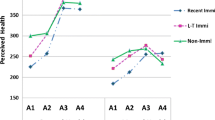Abstract
This study sought to understand the perceptions of Ghanaian immigrants of the health status and health trajectory of their community. We conducted focus groups and interviews with 63 primarily Ghanaian immigrants living in New York City. Nearly all participants observed that Ghanaians are generally healthy when they arrive in the US, but that their health declines over time. Participants identified four causes of this perceived deterioration: changes in health behaviors, increased stress, environmental exposures, and barriers to health care. Participants see themselves as being at risk for many health problems resulting from changes in lifestyle that follow immigration. Although some vulnerabilities are unique to their experience as immigrants, many of the risk factors they described are the same as those that affect other residents in the communities in which they live.
Similar content being viewed by others
References
Singh GK, Hiatt RA. Trends and disparities in socioeconomic and behavioural characteristics, life expectancy, and cause-specific mortality of native-born and foreign-born populations in the United States, 1979–2003. Int J Epidemiol. 2006;35(4):903–19.
Franzini L, Ribble JC, Keddie AM. Understanding the Hispanic paradox. Ethn Dis. 2001;11(3):496–518.
Sonis J. Association between duration of residence and access to ambulatory care among Caribbean immigrant adolescents. Am J Public Health. 1998;88(6):964–6.
O’Malley AS, Mandelblatt J, Gold K, Cagney KA, Kerner J. Continuity of care and the use of breast and cervical cancer screening services in a multiethnic community. Arch Intern Med. 1997;157:1462–70.
Gee EM, Kobayashi KM, Prus SG. Examining the healthy immigrant effect in mid- to later life: findings from the Canadian community health survey. Can J Aging. 2004;23(Suppl 1):S61–9.
Chavez N, Sha L, Persky V. Effects of length of stay on food group intake in Mexican American and Puerto Rican women. J Nutr Educ. 1994;26:79–86.
Guendelman S, Abrams B. Dietary intake among Mexican-American women: generational differences and a comparison with white non-Hispanic women. Am J Public Health. 1995;85(1):20–5.
Khan LK, Sobal J, Martorell R. Acculturation, socioeconomic status, and obesity in Mexican Americans, Cuban Americans, and Puerto Ricans. Int J Obes. 1997;21(2):91–6.
Sundquist J, Winkleby M. Country of birth, acculturation status and abdominal obesity in a national sample of Mexican-American women and men. Int J Epidemiol. 2000;29(3):470–7.
Diez Roux AV, Detrano R, Jackson S, et al. Acculturation and socioeconomic position as predictors of coronary calcification in a multiethnic sample. Circulation. 2005;112(11):1557–65.
McDonald JT, Kennedy S. Insights into the ‘healthy immigrant effect’: health status and health service use of immigrants to Canada. Soc Sci Med. 2004;59(8):1613–27.
Venters H, Gany F. African immigrant health. J Immigr Minor Health. 2009; http://www.springerlink.com/content/536212884g00h81w/.
Data on immigration from the NYC Department of City Planning (personal communication March 10, 2009).
Koya DL, Egede LE. Association between length of residence and cardiovascular disease risk factors among an ethnically diverse group of United States immigrants. J Gen Intern Med. 2007;22(6):841–6.
Bennett GG, Wolin KY, Okechukwu CA, et al. Nativity and cigarette smoking among lower income blacks: results from the healthy directions study. J Immigr Minor Health. 2008;10(4):305–11.
Bennett GG, Wolin KY, Askew S, Fletcher R, Emmons KM. Immigration and obesity among lower income blacks. Obesity. 2007;15(6):1391–4.
Harding S, Rosato M, Teyhan A. Studies in Europe: trends for coronary heart disease and stroke mortality among migrants in England and Wales, 1979–2003: slow declines notable for some groups. Heart. 2008;94:463–70.
Hamilton TG, Hummer RA. Immigration and the health of US black adults: does country of origin matter? Soc Sci Med. 2011;73:1551–60.
Kaplan SA, Ruddock C, Golub M, Davis J, Foley R, et al. Stirring up the mud: using a community-based participatory approach to address health disparities through a faith-based initiative. J Health Care Poor Underserved. 2009;20:1111–23.
Kaplan SA, Garrett KE. The use of logic models by community-based initiatives. Eval Program Plann. 2005;28:167–72.
Kaplan SA, Dillman KN, Calman NS, Billings J. Opening doors and building capacity: employing a community-based approach to surveying. J Urban Health. 2004;81:291–300.
Patil CL, Hadley C, Nahayo PD. Unpacking dietary acculturation among new Americans: results from formative research with African refugees. J Immigr Minor Health. 2009;11(5):342–58.
Data on immigration from the NYC Department of City Planning (personal communication March 10, 2009).
Patton MQ. Qualitative research and evaluation methods. 3rd ed. Thousand Oaks, CA: SAGE Publications; 2002.
Patil CL, Hadley C, Nahayo PD. Unpacking dietary acculturation among new Americans: results from formative research with African refugees. J Immigr Minor Health. 2009;11(5):342–58.
Holtzman JD. Food and memory. Annu Rev Anthropol. 2006;35(1):361–78.
Simbiri KOA, Hausman A, Wadenya R, Lidicker J. Access impediments to health care and social services between Anglophone and Francophone African immigrants living in Philadelphia with respect to HIV/AIDS. J Immigr Minor Health. 2010;569–579.
Kaplan SA, Calman NS, Golub M, Davis JH, Billings J. Racial and ethnic disparities in health: a view from the South Bronx. J Health Care Poor Underserved. 2006;17:116–27.
Olson EC, Van Wye G, Kerker B, Thorpe L, Frieden TR. Take care Highbridge and Morrisania, Second Edition. NYC Community Health Profiles. 2006;6(42):1–16.
Ramsden I. Teaching cultural safety. NZ Nurs J Kai Tiaki. 1992;85(5):21–3.
Agyei-Mensah S, de Graft Aikins A. Epidemiological transition and the double burden of disease in Accra, Ghana. J Urban Health. 2010;87(5):879–96.
Kaplan SA, Madden VP, Mijanovich T, Purcaro E. The perception of stress and its impact on health in poor communities. J Community Health. 2013;38(1):142–9.
Acknowledgments
This publication was made possible by a grant from the Carnegie Corporation of New York, with additional support from Bronx Health REACH and the United Hospital Fund. Significant assistance was provided by the African Muslim Council, the African Services Committee, the National Council of Ghanaian Associations, the Highbridge Community Life Center, and Bronx-Lebanon Hospital Center. The statements made and views expressed are solely the responsibility of the authors.
Author information
Authors and Affiliations
Corresponding author
Rights and permissions
About this article
Cite this article
Kaplan, S.A., Ahmed, R. & Musah, A. “When you walk in the rain, you get wet”: A Qualitative Study of Ghanaian Immigrants’ Perspective on the Epidemiological Paradox. J Immigrant Minority Health 17, 255–262 (2015). https://doi.org/10.1007/s10903-013-9873-x
Published:
Issue Date:
DOI: https://doi.org/10.1007/s10903-013-9873-x




